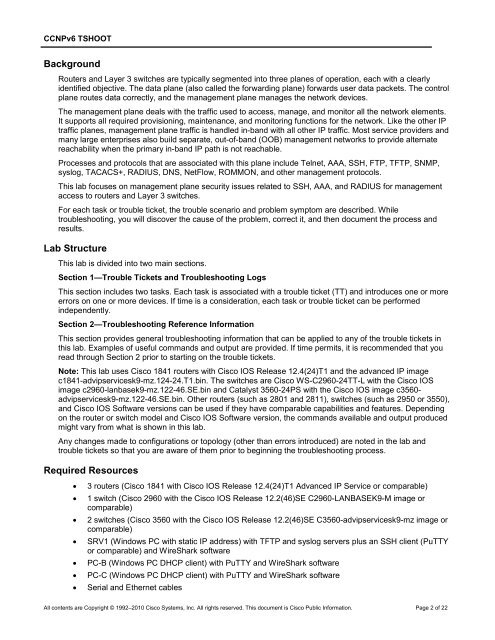CCNP TSHOOT 6.0 - The Cisco Learning Network
CCNP TSHOOT 6.0 - The Cisco Learning Network
CCNP TSHOOT 6.0 - The Cisco Learning Network
You also want an ePaper? Increase the reach of your titles
YUMPU automatically turns print PDFs into web optimized ePapers that Google loves.
<strong>CCNP</strong>v6 <strong>TSHOOT</strong><br />
Background<br />
Routers and Layer 3 switches are typically segmented into three planes of operation, each with a clearly<br />
identified objective. <strong>The</strong> data plane (also called the forwarding plane) forwards user data packets. <strong>The</strong> control<br />
plane routes data correctly, and the management plane manages the network devices.<br />
<strong>The</strong> management plane deals with the traffic used to access, manage, and monitor all the network elements.<br />
It supports all required provisioning, maintenance, and monitoring functions for the network. Like the other IP<br />
traffic planes, management plane traffic is handled in-band with all other IP traffic. Most service providers and<br />
many large enterprises also build separate, out-of-band (OOB) management networks to provide alternate<br />
reachability when the primary in-band IP path is not reachable.<br />
Processes and protocols that are associated with this plane include Telnet, AAA, SSH, FTP, TFTP, SNMP,<br />
syslog, TACACS+, RADIUS, DNS, NetFlow, ROMMON, and other management protocols.<br />
This lab focuses on management plane security issues related to SSH, AAA, and RADIUS for management<br />
access to routers and Layer 3 switches.<br />
For each task or trouble ticket, the trouble scenario and problem symptom are described. While<br />
troubleshooting, you will discover the cause of the problem, correct it, and then document the process and<br />
results.<br />
Lab Structure<br />
This lab is divided into two main sections.<br />
Section 1—Trouble Tickets and Troubleshooting Logs<br />
This section includes two tasks. Each task is associated with a trouble ticket (TT) and introduces one or more<br />
errors on one or more devices. If time is a consideration, each task or trouble ticket can be performed<br />
independently.<br />
Section 2—Troubleshooting Reference Information<br />
This section provides general troubleshooting information that can be applied to any of the trouble tickets in<br />
this lab. Examples of useful commands and output are provided. If time permits, it is recommended that you<br />
read through Section 2 prior to starting on the trouble tickets.<br />
Note: This lab uses <strong>Cisco</strong> 1841 routers with <strong>Cisco</strong> IOS Release 12.4(24)T1 and the advanced IP image<br />
c1841-advipservicesk9-mz.124-24.T1.bin. <strong>The</strong> switches are <strong>Cisco</strong> WS-C2960-24TT-L with the <strong>Cisco</strong> IOS<br />
image c2960-lanbasek9-mz.122-46.SE.bin and Catalyst 3560-24PS with the <strong>Cisco</strong> IOS image c3560advipservicesk9-mz.122-46.SE.bin.<br />
Other routers (such as 2801 and 2811), switches (such as 2950 or 3550),<br />
and <strong>Cisco</strong> IOS Software versions can be used if they have comparable capabilities and features. Depending<br />
on the router or switch model and <strong>Cisco</strong> IOS Software version, the commands available and output produced<br />
might vary from what is shown in this lab.<br />
Any changes made to configurations or topology (other than errors introduced) are noted in the lab and<br />
trouble tickets so that you are aware of them prior to beginning the troubleshooting process.<br />
Required Resources<br />
• 3 routers (<strong>Cisco</strong> 1841 with <strong>Cisco</strong> IOS Release 12.4(24)T1 Advanced IP Service or comparable)<br />
• 1 switch (<strong>Cisco</strong> 2960 with the <strong>Cisco</strong> IOS Release 12.2(46)SE C2960-LANBASEK9-M image or<br />
comparable)<br />
• 2 switches (<strong>Cisco</strong> 3560 with the <strong>Cisco</strong> IOS Release 12.2(46)SE C3560-advipservicesk9-mz image or<br />
comparable)<br />
• SRV1 (Windows PC with static IP address) with TFTP and syslog servers plus an SSH client (PuTTY<br />
or comparable) and WireShark software<br />
• PC-B (Windows PC DHCP client) with PuTTY and WireShark software<br />
• PC-C (Windows PC DHCP client) with PuTTY and WireShark software<br />
• Serial and Ethernet cables<br />
All contents are Copyright © 1992–2010 <strong>Cisco</strong> Systems, Inc. All rights reserved. This document is <strong>Cisco</strong> Public Information. Page 2 of 22

















